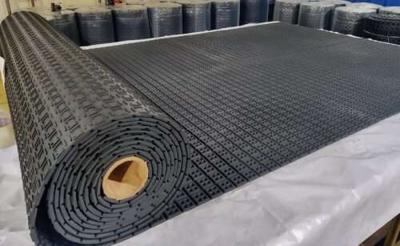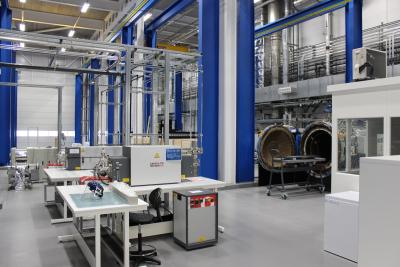In December 2018, Manchester University’s Graphene Engineering Innovation Center (GEIC) first opened, aiming to accelerate the commercial impact of graphene and help realize its potential to revolutionize many sectors.

James Baker, the CEO at Graphene@Manchester (G@M) who's responsible for the development and delivery of the business strategy which includes the National Graphene Institute (NGI) and the GEIC, kindly agreed to answer a few questions we had and update us on the latest from the GEIC.
In December 2018 the UK Engineering Graphene Innovation Center (GEIC) was opened in Manchester. Can you tell us of your experience from the GEIC so far?
Following the opening in 2018, much of the first 18 months have been spent commissioning the various kit and capability of the GEIC. Some of the equipment is unique and first to use a material like graphene and we have had to spend time in development and in commissioning to deliver the various applications involving graphene and 2D materials.
We have also been successful in signing up a number of initial industrial partners to the GEIC and today we have a number of industrial partners who might have a base in the GEIC as well as undertaking project work and we are starting to see starting to see some first initial successes in terms of graphene enhanced products and applications emerging from these projects.
There are over 40 companies now developing products at the GEIC. We'll be very happy to hear of some examples and how graphene is assisting these companies, and of course how the GEIC does.
The GEIC provides a flexible model which enables both large corporate, small and start-up/spin-out companies to engage with graphene and advanced materials across the University. Partners can have a base in the GEIC with their own dedicated lab or they can use generic labs or hot desk space to enhance the engagement between their businesses and the academics and GEIC engineering teams. The business model of the GEIC is different to that traditionally in a University, in that we can undertake rapid prototyping and exploration of products and applications involving graphene.
It is based on what I often refer to as a make or break model in that we can rapidly design and manufacture a component or prototype and then validate it. It might then either, fail fast or achieve success and then we can rapidly iterate it into a next stage of product development. In our first year of operation we are already seeing first products and applications entering the marketplace, unprecedented in terms of timescale for a new or advanced material into the market.

We are also working with a large number of small companies and spin-out organizations across Greater Manchester with some great recent successes including SpaceBlue and AEH.
How has the Corona pandemic affected the work at the GEIC?
When we went into lockdown in March 2020 due to the global coronavirus pandemic, I feared that it would cause major disruption to our activity and the commercialization of graphene and 2D materials. Whilst it did disrupt our ability to use the laboratories and undertake project work for several months, we actually used that time to engage with both existing partners but also to sign up and develop new partnerships and relationships with other companies. By using online tools such as zoom and teams we have actually accelerated some of the dialogue between partners and as we now have come out of lockdown and the GEIC labs have reopened, we are really seen a huge number of projects starting to take shape and in the development of new products across a range of applications and markets.
It seems as if the graphene industry is slowly maturing, with real value being added to products and some initial project successes. Can you give us your view on how the graphene industry looks like?
Despite graphene still only being 16 years since that first isolation in 2004, we are now starting to see the development of a supply chain taking place, in terms of companies who can make graphene material by the kilogram and tonnes and to a quality or standard and also a more affordable price.
We are also seeing the development of the supply chain who are making applications from composite's to energy to coatings to inks and formulations. There has been significant progress in new products and applications starting to come through and in the development of a supply chain for 2D materials for the future. The key change I am now seeing is that many companies who might have been cautious due to early graphene hype are now engaging actively around graphene.
Indeed I see the future where increasingly graphene will be contained within everyday products and applications without any knowledge of the consumer of its presence. This key change being that increasingly companies are using graphene not for the marketing but for the performance and benefits that it provides
What are the main challenges that you see in the market today? How is the GEIC helping with these challenges?
Key challenges today remain securing quality graphene at a good yield or quality and appropriate price although much progress has been made here. We also have challenges around future standards development including the development of new standards and regulation regarding graphene products and applications but again some good progress has been achieved in this area (e.g. REACH) over recent years.

The challenge is now less about graphene production but more about how we take the applications from the lab to the marketplace. As well is addressing the technology issues we also need to address the various manufacturing scale-up, commercial, regulation and environmental challenges that need to be overcome if a product is to be successful in the marketplace. The GEIC (and broader Graphene@Manchester including NGI, Royce and UoM academics) plays a central role in this, not only in terms of the facility, capability and know-how but also in terms of our partnerships and collaborations and in the creation of the Industry eco-system and supply chain necessary to take a product or application to market.
Not only do we have the challenges of graphene but following closely behind we have a number of other 2D materials moving very quickly through research and development. We are taking the learning from graphene and are applying this in terms of accelerating the application and scale up of future advanced materials which will create great challenge, opportunities and excitement for the future.
Thank you James, and good luck to you, the GEIC and all the member companies!